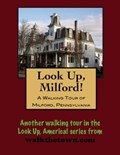There is no better way to see America than on foot. And there is no better way to appreciate what you are looking at than with a walking tour. Whether you are preparing for a road trip or just out to look at your own town in a new way, a downloadable walking tour is ready to explore when you are.
Each walking tour describes historical and architectural landmarks and provides pictures to help out when those pesky street addresses are missing. Every tour also includes a quick primer on identifying architectural styles seen on American streets.
In 1793, a deadly wave of yellow fever sept through Philadelphia, the nation's capital at the time. Those who could afford to leave, did. One who left was President George Washington, who moved to Germantown, about ten miles away. Another who could afford to leave was John Biddis. Biddis began his business career as a tavern owner who invented a new white lead paint in 1783. He opened a paint factory and soon was making the city's first wallpaper. Another invention tanned hides with gums from the barks of various trees. Biddis was 44 years of age when he removed his family from Philadelphia to the healthy air along the Delaware River in what was then known as Wells Ferry.
Thomas Quick had settled the area in 1733 and various ferries , most enduringly, one by Andrew Dingman. Biddis bought a huge swath of land, large enough to lay out 530 lots in 1796 and he had enough land left over that to sell his lots he offered buyers two acres of land outside of town for every acre purchased in town. Biddis was planning to begin paper construction in a mill to be built on the Sawkill Creek, the first in the United States to use wood pulp rather than rags (another invention of his) and so named his new village "Milford." Biddis soon had a second mill operating, this one reusing wool. In 1806 he was charged by the governor with building the first bridge across the Delaware River and was making plans to sell his various patent rights by lottery when he died. Many of his children took up residence here rather than Philadelphia and many of the street names you will be walking on carry their names - Ann, Catharine, and so on.
Pike County was birthed from Wayne County in 1814, named, like several around the United States, for explorer Zebulon Pike. Milford, the county seat, was incorporated in 1874. The first family of Milford was the Pinchots, who arrived in Milford in 1816 and opened a mercantile operation, The French Store. In 1850 by the time 19-year old James was ready to enter the family business there was no room so he trundled off to New York City and made a fortune in the wallpaper trade. He retired after 25 years and by 1886 he had built the French-influenced Grey Towers in his hometown.
At the time his son Gifford was 21 and instilled with a love of nature. When his friend Theodore Roosevelt became President in 1900, Gifford Pinchot was named the first Chief Forester of the United States Forest Service. During his tenure, national forests tripled in size to 193 million acres. Later, Pinchot became one of Pennsylvania's most popular and progressive governors, wiping out a $30 million budget deficit and paving rural roads to "get the farmer out of the mud." The Pinchots donated Grey Towers to the American public in 1963.
Our walking tour will begin at an historic building constructed by the Pinchots in 1907 that was intended for use by commercial shops on the first floor and for classrooms for Yale University's Forest School on the upper floors...

